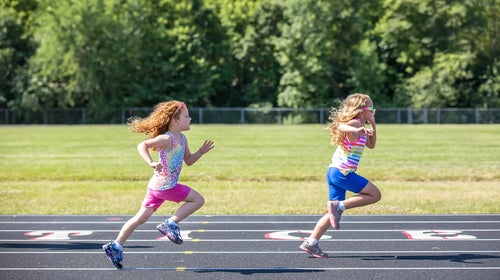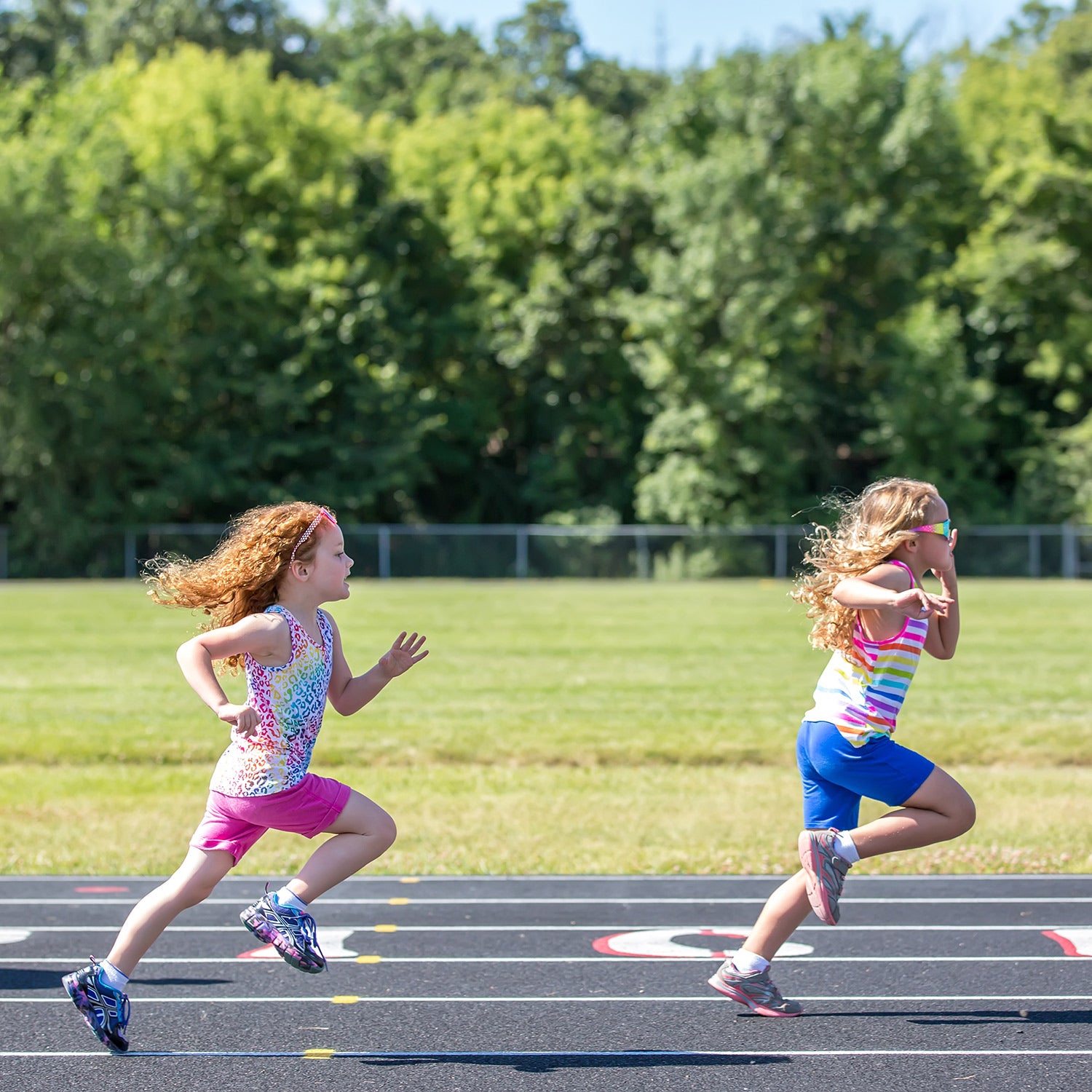When I was seven, my dad suggested on a whim that my nine-year-old sister and I run a 10K road race. He was not a runner and, as far as I know, did not have aspirations for us to become runners. For some reason, we agreed to it, though to say we ran is technically inaccurate. We jogged, walked, limped, and whined most of the way to the finish, and when we got to the end where Dad was waiting, he made us fake-crawl across the line so he could get a picture.
The experience could have easily turned us against running forever. The whole thing was Dad’s goofy idea, We hadn’t trained at all, and we ran alone, without an adult—basic no-no’s when it comes to introducing kids to the sport. The race clearly made a positive impression, though, because my sister went on to become a high school track star and I took up trail running and, later, ultras.
My girls are the same age as we were then, and they’ve started to show interest in running with me. It’s a fine line: I don’t want to foist it on them or assume they’ll love the sport—but, of course, part of me hopes they will. Here are a few pro tips to make running fun and safe and a positive experience for all:
Don’t Pressure, But Always Offer
When her daughter, Lanie, was little, ultrarunner and Ironman finisher Caroline Szuch made a point of inviting her to join her on short runs. For years the answer was no, but Szuch took it in stride. “Don’t guilt them,” she says. “Just come home and tell them how amazing it was.” Sure enough, when Lanie was six, she said yes. The two routinely run together now, though Lanie, a champion ultrarunner in the eighth grade, is always in front.
Look Out for Yourself
If you’re trying to get in a workout, get in your own miles early so that you’re tired and relaxed when you head out for an easy run with the kids, or treat the family run as a warm-up for your longer effort.
Start Slow
The million-dollar question: How much is too much and too soon? Experts like Bill Roberts, medical director of the Twin Cities Marathon, and Mark Halstead, a pediatric orthopedist, generally agree that children can run safely at any age as long as they’re excited to do so and don’t experience pain while running. (Though a little soreness afterward is normal.)
As little as once or a twice a week is perfect in the beginning. Before puberty, the priority should be creating healthy lifelong fitness habits rather than forcing a specific training program on kids. According to the Road Runners Club of America, “Between the ages of three and nine, encourage regular exercise, which can include organized running for fun…. Around the age of eight to twelve, children may enjoy participation in a more organized running program that has a more systematic training environment that lasts two to three months.” When in doubt, keep volume low, increase intensity and frequency gradually, and consult with your child’s doctor to prevent overuse injuries and burnout. Even at 13, Lanie Szuch rarely runs more than 15 miles a week.
Go Easy
As an ultrarunner, I have a slightly skewed perspective on distances and elevations. Fortunately my girls know this. “Yeah right, Mom,” they’ll groan when we’re out hiking, “the top is really ‘right up there.’” When starting out with kids, underestimate how far and high their little legs will carry them. Choose easy for real: start with a half-mile to a mile and build from there. Go for totally flat, as even a gradual incline that you may discount as “rolling” will seem like a mountain to a seven-year-old. Try the classic run-walk-run technique, encouraging them to jog the flats and downhills, walk the inclines, and catch their breath whenever necessary.
Hit the Trails
Natural obstacles like rocks, roots, boulders, and logs make trails inherently more fun and interesting than pavement. Dirt surfaces are also softer and therefore easier on little bodies—and big ones—than asphalt. Choose routes wisely: the best beginner trails have shade cover and no exposure to heights, drop-offs, or moving water. Even mud puddles become a source of great excitement for little ones—on a trail run last summer, my daughters and half a dozen other kids gleefully plowed straight through the puddles with their shoes on, then insisted on running the whole way back barefoot. We reluctantly allowed this, figuring the natural consequences of bruised or scraped feet might dissuade them from doing it again. We were right.
Join a Group
Plenty of youth organizations support noncompetitive running as a way for kids to improve stamina and fitness, build confidence, and foster a lifelong love of running. The national nonprofit Girls on the Run has over 200 councils nationwide, in every state, offering twice-weekly runs to empower girls in grades 3 through 8. Read Right Run is a St. Louis-based program that encourages kids ages five and up to run a marathon over 26 weeks—that’s one mile a week—while reading 26 books and doing 26 community service projects. The program culminates each year with a final 1.2 mile run that coincides with the St. Louis City marathon. With chapters across the country, the 100 Mile Club challenges school kids to run, jog, or walk 100 miles over the course of the school year, logging laps on the school track or gym. (You can also start your own.)
Whether it’s organized or not, it’s impossible to overstate the importance of enlisting other kids—the more the merrier. If you can’t find a local group, make your own. Over the summer, a friend and I started an informal trail-running club near our summer cottage in Ontario. The first week, 27 children ages six through twelve and assorted parents showed up, most of whom had never been trail running before. From the get-go, we kept it fun and non-competitive, on a flat 5K path through the forest. We didn’t have to worry about cars, and the out-and-back route made it easy to keep tabs on the kids. Parents were not required to run, but we made sure we had at least a handful of adults interspersed throughout the pack in case anyone went off trail, fell into a bog, or tripped and skinned a knee. A couple parents who preferred to walk acted as sweep, making sure everyone who went into the woods made it back out.
Keep It Regular
Our running club at Stony Lake had a standing date every Saturday morning, same time, same trail, to keep things simple and predictable. Once a week is plenty of running to whet their appetite without burning them out. Though we never timed the run, it was inspiring for everyone to see the kids getting faster and more confident as the summer progressed. One 12-year-old girl loved it so much that she joined her middle school cross-country team.
Gear Up
The other day, my husband and I took our daughters out for a three-mile run on a rolling loop. We weren’t ten minutes in when our youngest began to complain that she was thirsty. Figuring the run would take 40 minutes at most, and it was 50 degrees outside and overcast, we’d brought no water or food. Her thirst became a stand-in for everything that annoyed her about running that day, which was everything. At one point, she lay face down in the dirt in the middle of the trail, beating her fists into the ground. We had to cajole her to walk and jog rest of the way, but she ultimately made it to the end, smiling—and she made her point. Now we don’t leave the house without a lightweight running vest with 20 or 30 ounces of water in the reservoir. Ultimate Direction’s Half Marathon Vest is made for adults, but can cinch down to fit kids, is lighter than many kids’ hydration packs, and has enough storage for a couple of energy bars, a jacket, and a pair of gloves. Also, invest in decent trail running shoes with good traction, like Solomon’s Speedcross J, so they don’t slip and face-plant in the dirt like said daughter did recently. Ouch.

